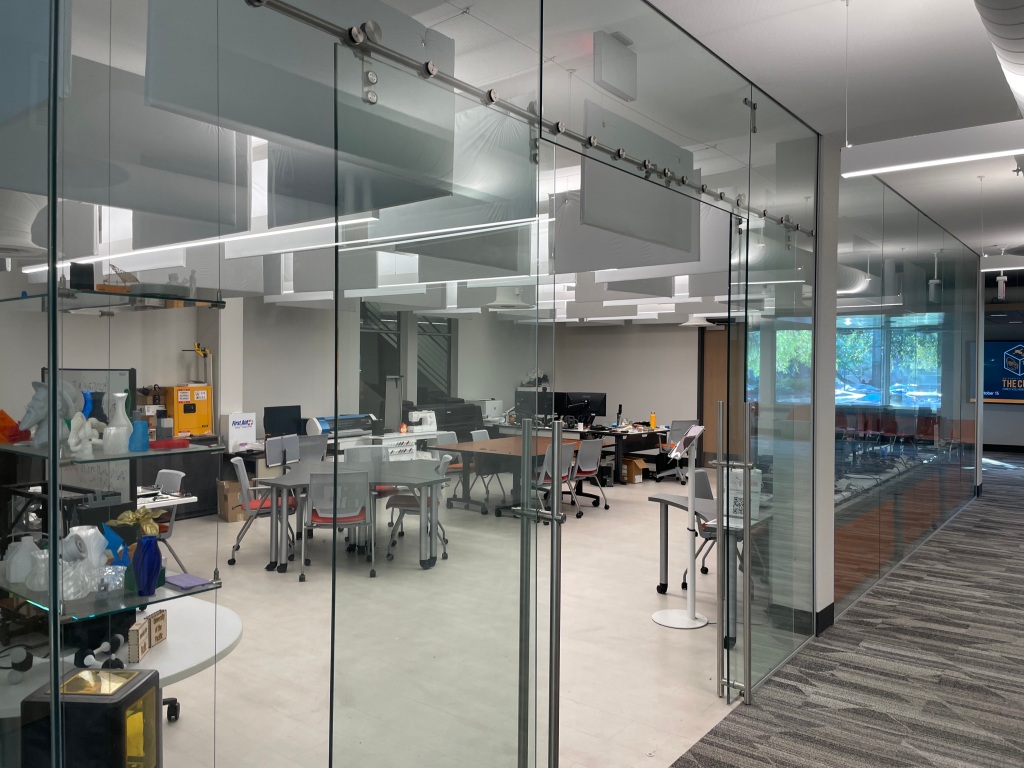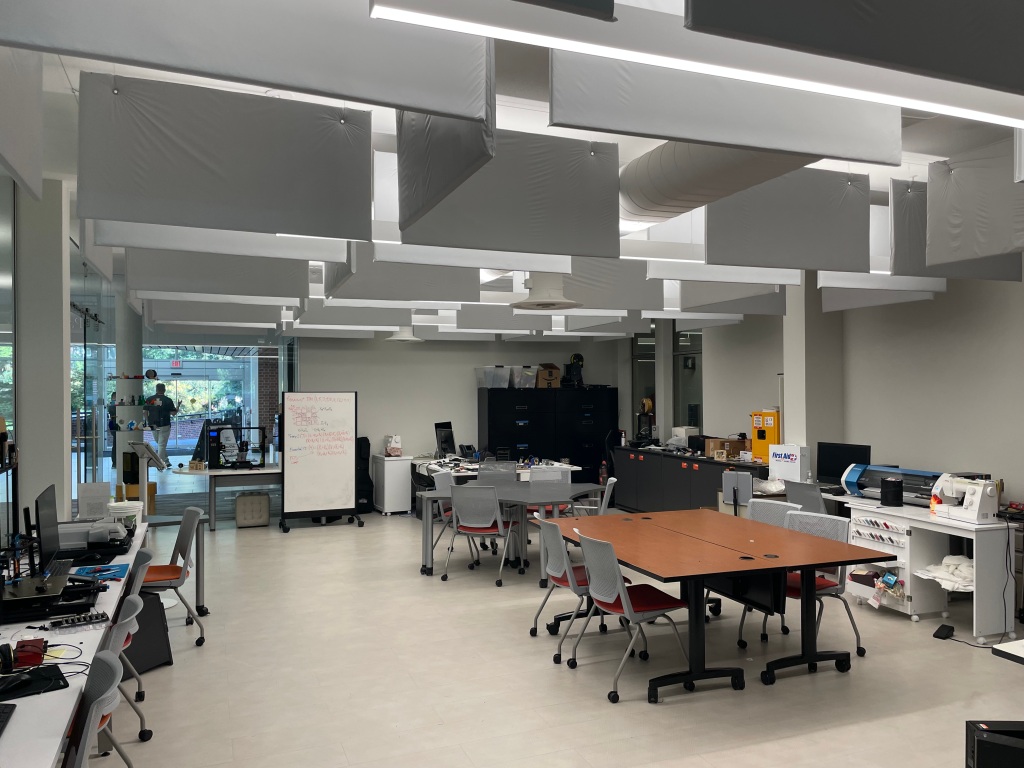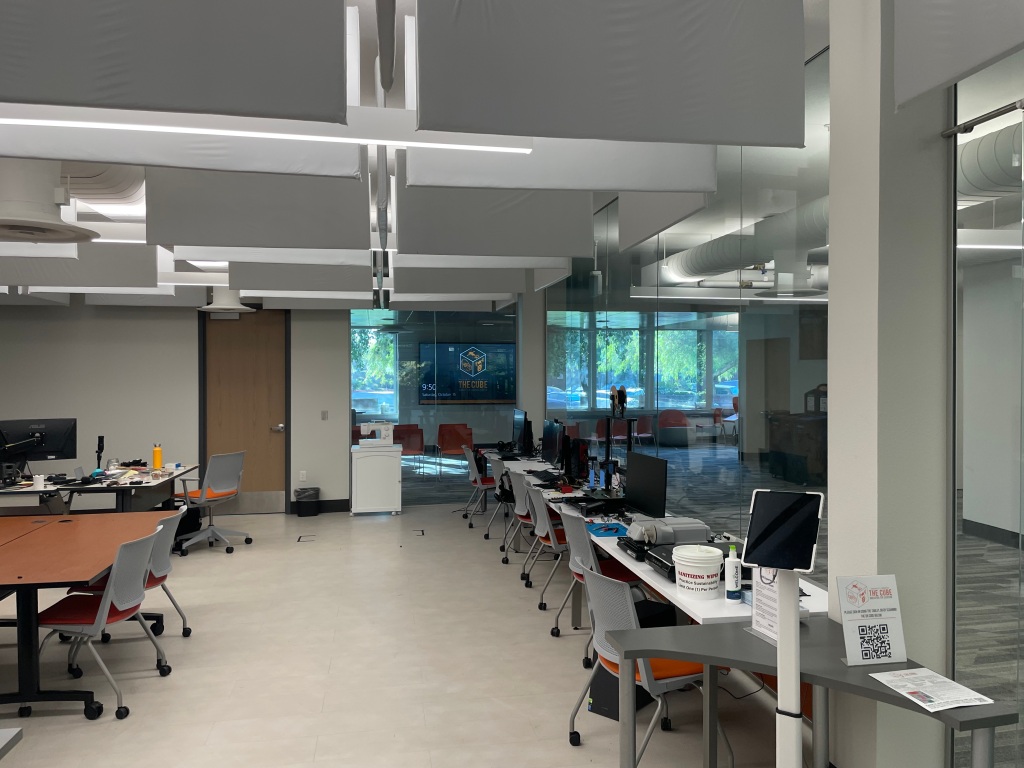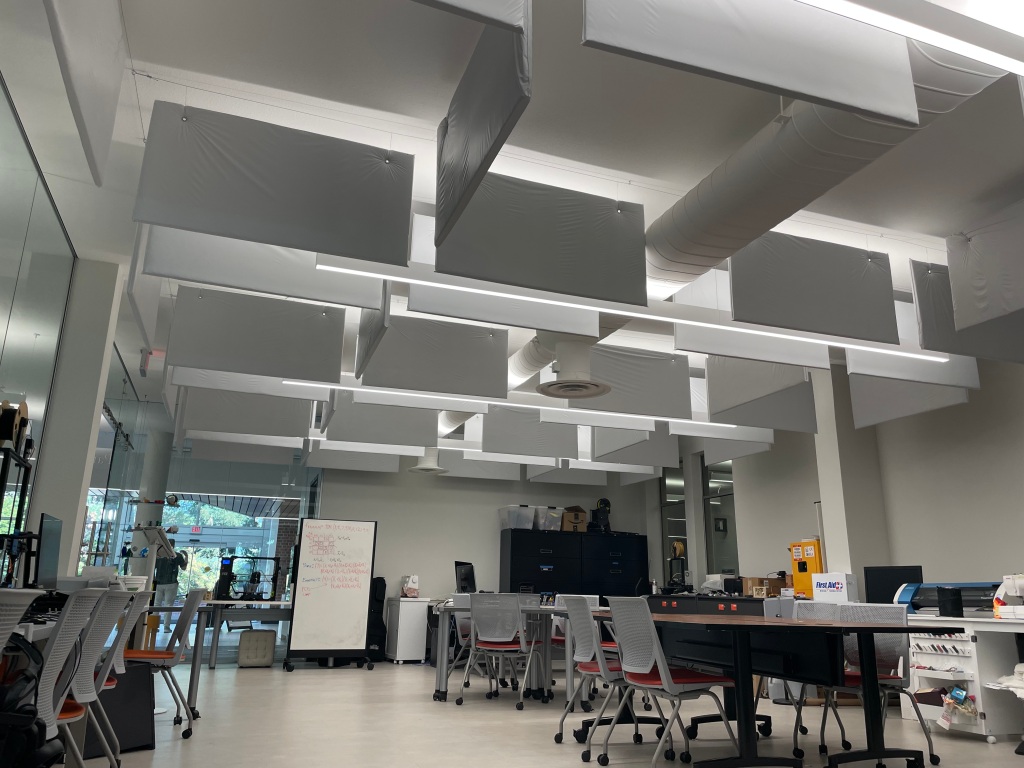Archive for category Classrooms
Taming the Cube with Cloudscape®
Posted by Acoustics First in Absorption, Classrooms, Customer Feedback, Manufacturing, Media Room, Product Applications, School & Educational Facilities, Teaching Rooms, Universities on October 21, 2022
When the University of the Pacific reached out to help tame the acoustics of their makerspace called “The Cube”, many different concerns were underlined about the space, its uses, and the problems they faced.

These concerns covered more than just the room dimensions – size, height, HVAC, glass walls, etc…. there were functional requirements for collaboration, classes, and workshops. The overwhelming acoustic problems involved the near constant noises generated by the vast array of equipment in this space – sewing machines, large format printers, plotting cutters, 3D printers, scanners, and every other modern tool for allowing the creative minds at their school to create. It was a cacophony of stepper motors, fans, and moving parts – which made collaboration very difficult.

The other parameter that needed to be maintained was the ability to reconfigure the layout of the equipment without affecting the acoustic treatment in the space. This removed almost all of the walls in the space as possible locations for treatment. This left the ceiling as the only viable space left for treatment, but with an array of lights and exposed HVAC systems, there were few treatments that would be easy to implement and still be effective.

The decision was made to creatively weave Cloudscape® Baffles into all the spaces available in the ceiling. Dodging duct-work and suspended lighting rails was made possible with careful planning and execution – and the results were immediately notable. (Also noticeable was that the baffles had very little impact on the lighting which is vital in any makerspace.)

“…The sound baffles you recommended finally got installed in my makerspace about two weeks ago and I wanted to send a quick thank you since they’ve made a very noticeable acoustic difference to the room, and it’s a lot more pleasant in here now. “
Chris Crawford – Innovation Spaces Manager (University of the Pacific)
Silent Pictures® goes BIG for Ditch Witch®
Posted by Acoustics First in Absorption, Classrooms, Customer Feedback, Product Applications, School & Educational Facilities, Teaching Rooms, Uncategorized on September 16, 2021

When Ditch Witch® needed to acoustically treat their training room, they had a big and bold idea – take a cool promo photo and use that to make a Silent Pictures® mosaic! The required scale made it easier to break up the photo into a 3’x3′ matrix, which also eased the shipping and installation process! The final product (at over 9 feet tall and 15 feet wide) is imposing, and while it isn’t quite life-sized, the impact is indeed massive!
“Thank you so much for all the help you and your team did on this project. Our training room is complete now.
Ditch Witch Midwest
We are over the moon happy.”
Little Safari Day Care – creating peace (and quiet), one pyramid at a time.
Posted by Acoustics First in Absorption, Classrooms, Customer Feedback, Multipurpose Rooms, Product Applications, School & Educational Facilities, Teaching Rooms on August 11, 2021
With more parents returning to the office, we’ve recently received a handful of treatment requests from day-care facilities dealing with an influx of boisterous children.
Little Safari Day care reached out to us in July 2021 for help with their space. Little Safari’s multi-purpose room is used for play, music, reading, arts/crafts, meals, games etc….. lots of moving and laughing = lots of noise! According to the owner “The noise level is deafening at times to the point you can’t hear anything, just noise”

The fanciful mural on the playroom wall looks great, but when you look closer, that glossy painted surface reflects sound like glass! Luckily, Fireflex Pyramid foam can quiet that down!
Technical consultant Cameron Girard settled on a remediation package that included FireFlex Acoustic Pyramid Foam panels distributed throughout the ceiling of the multi-purpose room. Safe to say, they were very happy with the results!!

The checkerboard install of the foam helped to distribute the absorption over the loudest areas of the room.
From the owner…..“Cameron, Thank you for all of your help and expertise in sound suppression!!! I have had people tell me upon entering the front door “wow, it’s much quieter in here” Such a noticeable difference. You may have saved my hearing and sanity!!!”
University of Miami – Frost School of Music
Posted by Acoustics First in Classrooms, Press Release, School & Educational Facilities, Uncategorized, Universities on April 29, 2019
Students at the Frost School of Music had an “ear-opening” experience when their Computational Psycho-acoustics class was lectured by Jim DeGrandis of Acoustics First last month. The topics ranged from engineering to human perception of ultrasonic frequencies. The students were exposed to concepts and demonstrations of ultrasonic frequencies which have been modified in ways to make them audible, and ultrasonic anomalies affecting the audible range in ways that are very blatant and obvious.
One of the most stark examples of “audible ultrasound” being the demonstration of a Parametric Speaker, which modulates the ultrasonic carrier to produce very directional audible frequencies.

Computational Psycho-Acoustics at Frost School of Music – University of Miami. Dr. Chris Bennett (far left) and Jim DeGrandis (in signature cap – center) [photo credit: Gonzalo Mejia]
Jim also spoke at the student forum about misconceptions of what it really means to be “in the industry” …and did an encore demo of the Parametric Speaker – which had apparently been such a novel experience for the Psycho-Acoustics class that they ‘demanded’ it be experienced again by a wider audience. (and it was just plain fun!)
Sound Channels® – Top Product!
Posted by Acoustics First in Absorption, Classrooms, Customer Feedback, Mentions, Press Release, School & Educational Facilities on December 22, 2015
Acoustics First® Sound Channels® wall fabric has been named a ‘2015 Top Product’ by Christian School Products magazine!
http://www.cspmagdigital.com/publication/?i=284531&p=18

Christian School Products – 2015 Top Products
This article from their November issue explains why:
Merry Christmas and Happy New Year from all of us at Acoustics First!


You must be logged in to post a comment.